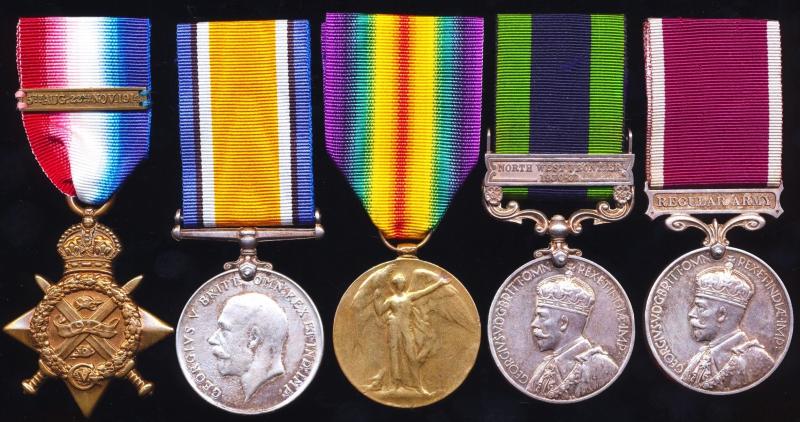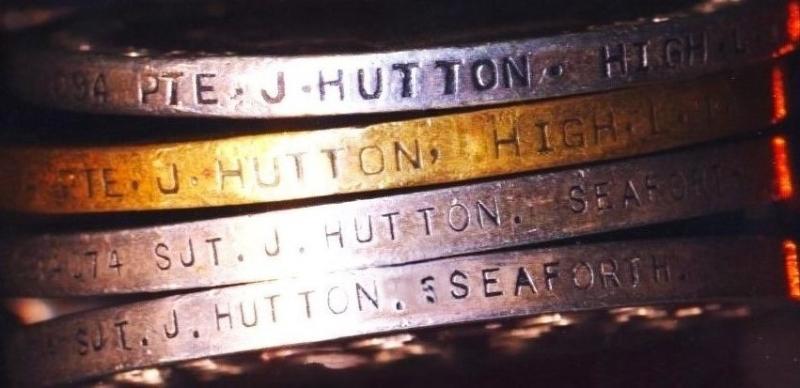A 1914 Casualty, North West Frontier & Long Service group of 5 to a Jock who served in 3 x different Scottish regiments: Sergeant John Hutton, 2nd Bn Seaforth Highlanders, late 14th Bn Highland Light Infantry & 1st Bn Scottish Rifles (Cameronians)
- 1914 Star. With contemporary tailors copy dated clasp (10918 Pte. J. Hutton. 1/Sco: Rif.)
- British War Medal. Silver issue (29094 Pte. J. Hutton. High. L. I.)
- Interallied Victory Medal 1914-19 (29094 Pte. J. Hutton. High. L. I.)
- IGS 1908 Medal. GV 'North West Frontier 1930-31' (2814074 Sjt. J. Hutton. Seaforth.)
- Military LS&GC Medal. GV issue with 'Regular Army' bar (*814074 Sjt. J. Hutton. Seaforth.)
* First digit of regimental number on LS&GC only worn due to contact wear
Wounded-in-Action: In France on 19 November 1914, Private John Hutton 1st Battalion Scottish Rifles was 'Wounded-in-Action', by 'Gunshot & Shrapnel Wound', or GSW, to the right arm. The severity of the wounds resulting in his return to the United Kingdom for treatment and recovery
Medals and clasps verification: All medals and both clasps verified as entitled per below following cited medal rolls and references:
- 1914 Star: WO 329/2448 shows transferred to 4th Battalion Highland Light Infantry
- British War Medal. Silver issue: WO 329/1635 shows prior service with 1/Scottish Rifles
- Interallied Victory Medal 1914-19 : WO 29/1635 shows prior service with 1/Scottish Rifles
- IGS 1908 Medal. With clasp 'North West Frontier 1930-31': WO 100/495_3. The medal roll compiled & signed at Haifa, Palestine, 11 September 1933
- Military LS&GC Medal. GV issue with 'Regular Army' bar: Army Order of date 31 October 1933
Dated clasp: Neither the medal roll or medal index cards are marked to show that the recipient was issued with a clasp. That notwithstanding, the recipient was without question entitled to the dated clasp, as his 'Wounded-in-Action' status testifies. Moreover the recipient is verified by the photographic evidence supplied as the recipient clearly wore a dated clasp on his 1914 Star - the same claps p here included with the medals......
John Hutton was a native of Greenock, Renfrewshire, Scotland, where he was born on, 14 December 1894. He enlisted into the Scottish Rifles (Cameronians) aged 18 on, 3 January 1913 at, Lichfield , Staffordshire, England, having previously served with the 4th (Special Reserve) and 5th (Territorial) Battalions of the North Staffordshire Regiment. By the time of his enlistment, he was an orphan, his surviving family being his brother Robert (who was 'Killed-in-Action on, 14 August 1918, while serving with the Royal Scos Fusiliers) and his sister Jean who was living at 14 Mount Pleasant Street, Greenock
At the outbreak of the Great War, John, now a Lance Corporal, was serving with 1st Battalion of the Scottish Rifles, located at, Maryhill Barracks, Glasgow. 1/Scottish Rifles embarked by train for Southampton late on 13th August 1914. Next day, the battalion embarked on the SS “Caledonia” and sailed for France where they landed on the 15th August 1914. The Battalion came under orders of 19th Infantry Brigade - which was not allocated to a Division - was an independent command at this time. On the 12th October 1914 the 19th Infantry Brigade joined the 6th Division. On the 22nd September 1914, John was reverted to Private for misconduct. 2 months later on, 19 November 1914, Private Hutton was 'Wounded-in-Action', receiving a gun shot wound to his right arm. He was evacuated back to Britain on the 28th November. After recovering form his wounds, John was later transferred to the 14th Battalion of the Highland Light Infantry on the 1st April 1916. This was a Service battalion, part of Kitchener’s New Armies. They had not yet seen action but soon would as Private Hutton and his new Battalion landed in France on the 3rd June 1916.
After arriving in France the 14th HLI as part of the 120th Brigade in the 40th Division concentrated near Lillers. They went into the front line near Loos and were later in action in The Battle of the Ancre on the Somme. In 1917 they saw action during the German retreat to the Hindenburg Line, the capture of Fifteen Ravine, Villers Plouich, Beaucamp and La Vacquerie and the Cambrai Operations, including the capture of Bourlon Wood in November. In 1918 they fought in the Battle of St. Quentin and the Battle of Bapaume on the Somme then the Battle of the Estaires and the Battle of Hazebrouck in Flanders, suffering heavy losses.
The Division was reduced to a cadre and were reorganised, on the 3rd June the 14th HLI transferred to the 34th Division, then on the 17th to the 39th Division. On the 16th August they once again transferred, this time to the 197th Brigade, 66th (2nd East Lancashire) Division, returning to action in October in the Battle of Cambrai and the Pursuit of the Selle. They fought in the Battle of the Selle and on the 21st October the Division was withdrawn for rest moving to the Serain area. On the 2nd of November they advanced through Le Cateau engaging in sharp fighting. On the 9th November a number of units of the Division were selected to advance through Belgium to occupy the Rhone Bridgeheads and were placed under command of Bethell’s Force. At the Armistice the advanced units of this Force were on the line of Pont de Republique through Granrieu to Monbliart. They advanced into German and remained there until demobilised. According to Private Hutton’s service record he remained with the 14th HLI throughout all these operations and transferred to the 9th Highland Light Infantry which was still in Germany on the 4th May 1919. He arrived back in Britain on the 6th January 1920 were he was posted to for discharge, which he finally received on the 2nd February 1920. For his part in the Forst World War, Private Hutton was awarded the 1914 Star with clasp, British War Medal 1914-18 and the Interallied Victory Medal 1914-19
John would go on to work as a Craneman in Ayr but obviously missed Army life and was probably struggling like the rest of post-war Britain. So on the 1st July 1922, aged 27, he enlisted into the Seaforth Highlanders. While at the depot he was posted to Lance Corporal after completing his training on the 26th October 1922. On the 21st November 1922 Lance Corporal Hutton was posted to the 2nd Battalion which was in India. 2/sSeaforth had arrived in Meerut in November 1919. From Meerut, 2/Seaforth were sent for a year’s duty on the North-West Frontier at Landi Kotal. Having moved to Umballa by train in November 1922, the Battalion marched the 500 miles to the North-West Frontier. This is where L/Cpl. Hutton joined them. The march took nearly two months, covering up to 23 miles a day led by the magnificent 'Pipes and Drums' and the Military Band playing on alternate days during the march. 2nd Seaforth spent over a year on the North-West Frontier until moving to Nowshera in 1924. On the 5th January 1926 John was promoted to Corporal. In 1927 the Battalion marched the 250 miles to its next station at Lahore. Corporal Hutton was once again promoted this time to Lance Sergeant, on, 2 November 1928
Lance Sergeant Hutton returned to Britain after 6 years and 101 days in India. He was posted to the 1/Seaforth to complete his training to become a full Sergeant. He was taken on the strength on, 2 March 1929, while the 1st Battalion was station at Dover, here the Battalion trooped the Regimental Colour before HRH The Prince of Wales. L/Sgt. Hutton features in the photograph of 1st Bn. Seaforth Highlanders with H.R.H. The Prince of Wales (Colonel in Chief) and Members of the Sergeant’s Mess – Dover, 27th June 1929. John became a full Sergeant on, 11 January 1930. After this he set sail back to India and was re-joined 2/Seaforth, now at Jhansi Cantonment, on, 1 March 1930
In August 1930, the 2nd Battalion Seaforth Highlanders returned to the North West Frontier for operations against the Afridi tribesmen. From a base at Miri Khel, west of Peshawar, the Battalion helped to build roads and strongpoints to prevent infiltration by the Afridis. They also saw active service against the tribesmen on several occasions. On the 5th December 1931, Sergeant Hutton reengaged to complete his full 21 years with the colours. He was awarded the India General Service Medal with North West Frontier 1930-31 Clasp
Sergeant Hutton and 2/Seaforth moved to Haifa in Palestine on the 10th Decmber 1932. This was the last part of the Battalion’s foreign service tour. After a peaceful and uneventful start, Jewish immigration increased, and in late 1933 demonstrations and riots developed as Arab resentment grew. In December 1933, 1/Seaforth also arrived in Palestine at the start of its foreign tour. It was the first occasion where both of the regular battalions of the Seaforth Highlanders had met overseas in peacetime. Sergeant Hutton was presented with his Long Service and Good Conduct Medal in Haifa on, 25 January 1934. After 1 year and 136 days in Palestine with 2/Seaforth, Hutton and his unit sailed back to Britain
On return to the United Kingdom, 2/Seaforth were based at Dover Castle, where 1/Seaforth, had very recently been located. On 12 February, Sergeant Hutton was posted to the 4th/5th Battalion Seaforth Highlanders (Territorial Army) with whom he served until his discharge from the British Army on, 31 October 1937
Sold with a raft of hard-copy 'Service Papers' & a quantity of soft-copy images (see below listed) from the regimental journal, that will be sent to the buyer by email attachment including :
- “B” Company Boxing Team, 2nd Battalion, Landi Kotal, “Winners of the Tarlogie Trophy, July 1923
- 2nd Battalion Officers v. Sergeants Football Match, New Year, 1928
- “A” Company – 2nd Battalion The Seaforth Highlanders
- 1st Bn. Seaforth Highlanders with H.R.H. The Prince of Wales (Colonel in Chief) and Members of the Sergeant’s Mess – Dover, 27th June 1929
- Presentation of Long Service and Good Conduct Medal by Brigadier J. C. Browne, CMG DSO ADC – Haifa, 25th January 1934
- Officers and Sergeants, 2nd Battalion, Haifa, April 1934
- Presentation of Colours, 5th July 1935 – Officers and Sergeants Group
Note: The recipient is identified by name in all, or most of the above listed copied images
An unusually well documented - and scarce seen Great War and Inter-War campaign medal and long service medal group seen named to three different Scottish infantry regiments
Contact wear commensurate with age and frequent wear by a long serving senior Seaforth NCO
Condition: Great War medals GF others VF
Code: 24346







